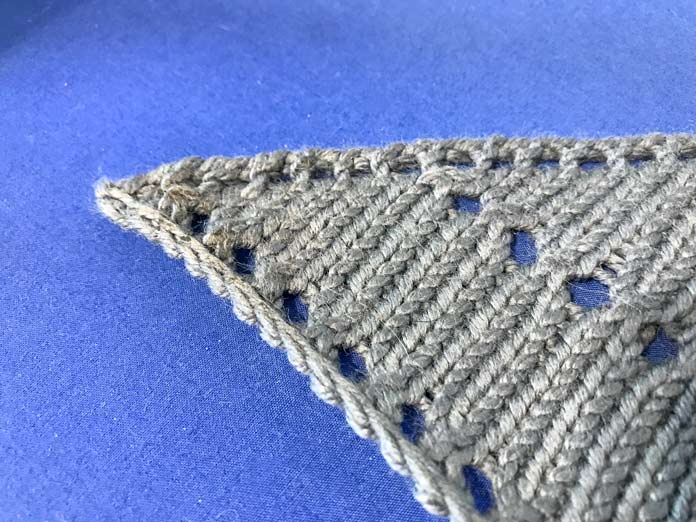When I blocked the Simple Lace Triangle Shawl we talked about yesterday, it went from this curly crumpled triangular-ish shaped garment to a beautiful shawl. One comment I receive from a lot of people is how perfect my stitches look on knitted garments. Blocking goes a long way to making those stitches look absolutely perfect. They lay flat and fall in line with their brothers and sisters. It even makes errors less noticeable.

Here’s my ‘before’ picture. This shawl was fresh off the needles, cast off and onto the blocking board.
First thing is first when blocking, you need to decide how you’re going to do it. There’s wet blocking and steam blocking. Wet blocking takes a bit longer and I’d definitely suggest starting out with wet blocking if you’re not entirely familiar with the process. It’s a bit more forgiving. It’s easy enough to do, you saturate your entire garment with water, then gently press the excess water from it. You then lay it out on a surface where you can pin it out and leave it to dry. I know I’m going through this at rapid-fire speed but it is very easy to find highly detailed instructions on how to block your knitted garments. I just want to give you a brief overview and a couple tips and tricks that will make it easier.

This is what the eyelets looked like before blocking. You might want to scroll back to this photo after you see the end result.
Steam blocking is my favorite way to block and, I’ve discovered lately, much less common. I steam blocked the Simple Lace Triangle Shawl made with Chic Sheep. When I block my garments. I usually don’t have 12-24 hours to leave something to dry. I have cats who get into everything and while I might be able to close off one whole room in my house to let something settle into its final shape, it’s just not practical for me to do all the time.

This is the corner of the shawl after unpinning. No curling, no rolling, a perfect pointed corner. Look at those eyelets! They’re much bigger and more noticeable.
With the Simple Lace Triangle Shawl, I pinned out the top first. Usually, you can get length or width from a garment, but not both. With shawls, I prefer width so I make that line first. Then I make sure all the eyelets are open and you can see that yarn detail. If you’re blocking a sweater and you think it might be a bit too short, you can block it a bit longer, or if your armhole is a bit too small, you can block that bigger.
The beautiful thing about wool is its memory. Natural wool remembers the shape it wants to be in and when you use water or steam to set it in a shape, it will naturally want to bounce back.

Here’s my ‘after’ picture! First of all, look at the size difference. That’s the same iron and board. The blocking has increased the size, but mostly because I aggressively blocked it to open all the lacework.
With synthetic fibers, they usually relax when blocked, but wool reacts differently. If you’re knitting with a new yarn, whether it’s Chic Sheep or something else, I would highly suggest knitting two swatches and blocking them. You need to know how the yarn will react to steam and/or water. This is very relevant to garments you intend to wash. If the wool is going to bloom, the garment will have a very different look. You can never have too much information when it comes to your knitting. Swatch!
This is part 3 of 5 in this series.
Go back to part 2: A simple lace triangle shawl is luxurious knitted with Chic Sheep yarn
[shareaholic app=”follow_buttons” id=”23784471″]
